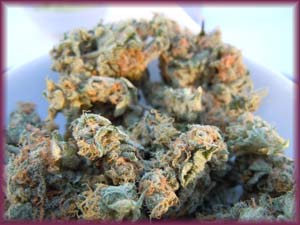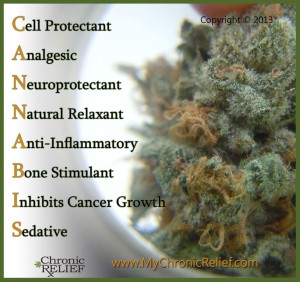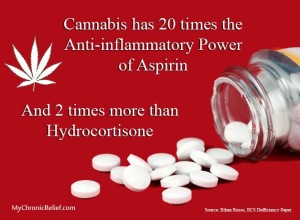Cannabis 101: THC & CBD
PAIN RELIEF
 Cannabis is a flowering plant. When cannabis is grown for medicine, the flowers (also known as buds) and leaves of the female plant are cured resulting in what we generally regard as cannabis, or the more commonly used pejorative term “marijuana”. Hemp and medicinal cannabis are in the same genus – cannabis, (cannabis sativa, cannabis indica, and hybrids), and both have psychoactive qualities and pain relief capabilities. The difference is in breeding/growing methods – hemp is grown for its fiber, which is used to make clothing, rope, paper, etc., and medicinal cannabis is bred to have larger buds and more psychoactive compounds and pain relief. Highly versatile, cannabis provides pain relief for many different ailments and symptoms with a high degree of safety. Sound like Snake Oil to you? It’s not. The reasons that cannabis benefits so many different illnesses and ailments boils down to the fact that some of the active pharmacological components of the cannabis plant mimic an internal chemical harm reduction system in the human body that keeps our health in balance – the Endocannabinoid System (ECS).
Cannabis is a flowering plant. When cannabis is grown for medicine, the flowers (also known as buds) and leaves of the female plant are cured resulting in what we generally regard as cannabis, or the more commonly used pejorative term “marijuana”. Hemp and medicinal cannabis are in the same genus – cannabis, (cannabis sativa, cannabis indica, and hybrids), and both have psychoactive qualities and pain relief capabilities. The difference is in breeding/growing methods – hemp is grown for its fiber, which is used to make clothing, rope, paper, etc., and medicinal cannabis is bred to have larger buds and more psychoactive compounds and pain relief. Highly versatile, cannabis provides pain relief for many different ailments and symptoms with a high degree of safety. Sound like Snake Oil to you? It’s not. The reasons that cannabis benefits so many different illnesses and ailments boils down to the fact that some of the active pharmacological components of the cannabis plant mimic an internal chemical harm reduction system in the human body that keeps our health in balance – the Endocannabinoid System (ECS).
The ECS is controlled by chemicals that our body produces called endocannabinoids. Our endocannabinoids are responsible for keeping our most critical biological functions in balance such as sleep, appetite, the immune system, pain and more. When the body gets out of balance and moves into a state of stress, endocannabinoids go to work to fix the problem. The pharmaceutically active components in the cannabis plant mimic endocannabinoidsand so can be effective in helping the body manage crises and restore itself after trauma when the body’s endocannabinoids are not able to restore balance alone.
You are probably wondering, “Why does cannabis benefit so many different illnesses?” The short answer is that the cannabis is highly effective in treating pain and inflammation. It does this by working with the endocannabinoid system, which controls pain and inflammation. Can you think of a disease that does not come with inflammation and pain? I can’t.
The cannabis plant happens to be one of the most (if not the most) pharmacologically active plants on the planet, containing over 400 active chemicals. The unique active components of cannabis are called cannabinoids, which are found alongside active chemicals called terpenoids(we also refer to them as terpenes)and flavonoids. These chemical components work together to provide a wide variety of therapeutic benefits to the human body.
 Various levels and combinations of cannabinoids, terpenoids and flavonoids provide many benefits to the human body, dilating blood vessels, stimulating bone growth, protecting damaged brain cells, killing certain kinds of cancer cells, preventing seizure, controlling muscle spasticity, killing viruses and bacteria to name a few. It is the combination of varying levels of cannabinoids, terpenoids and flavonoids that seem to make the most effective medicine for specific symptoms and dis-eases – the isolated components appear to be less effective but nonetheless still therapeutic.
Various levels and combinations of cannabinoids, terpenoids and flavonoids provide many benefits to the human body, dilating blood vessels, stimulating bone growth, protecting damaged brain cells, killing certain kinds of cancer cells, preventing seizure, controlling muscle spasticity, killing viruses and bacteria to name a few. It is the combination of varying levels of cannabinoids, terpenoids and flavonoids that seem to make the most effective medicine for specific symptoms and dis-eases – the isolated components appear to be less effective but nonetheless still therapeutic.
Cannabis has been found to ease general pain, chemo induced neuropathy, and nausea, as well as increase appetite and reverse wasting. It is also effective in controlling muscles spasms and seizures, healing damaged brain cells, protecting against the ravages of Alzheimer’s, and is an effective antioxidant.
While there are over 100 different cannabinoids that can occur in cannabis, the two most well known and studied compounds in the cannabis plant happen to also be the two that occur in the largest volume: delta-9 tetrahydrocannabinol, commonly referred to as THC, and cannabidiol, known as CBD. Like all other cannabinoids, these two must be heated to convert the cannabinoid acid to the active cannabinoid. THC is the primary psychoactive component of cannabis which gives the effect of what recreational users call the “high.” CBD is considered to be non-psychoactive and when used in conjunction with THC helps dampen the psychoactivity and other side effects some people consider undesirable. Both cannabinoids have an impressive list of ways they support the human body.
THC is a strong anti-inflammatory providing pain relief and has been shown to reduce the amyloid plaques in the brain that cause Alzhiemer’s. In pre-clinical trials THC has been proven to reduce levels of vascular endothelial growth factor (VEGF) in glioma (brain cancer) cells. This is important because a reduction in VEGF means that brain cancer tumors are unable to grow the new blood vessels they need to sustain themselves, grow and spread. This discovery offers great promise for the treatment of brain cancer.
THC is also a bronchodilator, anti-spasmodic, muscle relaxant, a powerful neuroprotectant and antioxidant. In fact, it has 20 times the anti-inflammatory power of aspirin and twice that of hydrocortisone.

CBD is the second most common cannabinoid in cannabis and the most common in hemp plants. CBD can generally represent 0.1-12 percent of the cannabinoid content of the the plant. CBD rich cannabis (4% or more) provides potent therapeutic benefits without the euphoria or lethargy of many high THC varieties. CBD and THC are believed to have a synergistic effect meaning that when they are both present at therapeutic levels, they are more effective together than they are alone. While THC is widely known for its psychoactive properties, CBD may be best known for its ability to counterbalance anxiety, pain relief, tachycardia (rapid heartbeat), hunger and sedation caused by THC and its ability to control sever forms of epilepsy. Removing the THC and other plant matter and waxes leaves 95% or greater CBD for great pain relief.
CBD was once considered a minor cannabinoid under the shadow of THC. What we know now is that CBD is as beneficial and versatile a cannabinoid as THC in addressing many hard to manage conditions such as diabetes, rheumatoid arthritis, cancer, epilepsy, antibiotic-resistant infections, alcoholism, PSTD and neurological disorders. CBD has very strong anxiolytic (reduces anxiousness), anti-convulsant, anti-emetic (reduces nausea), anti-inflammatory pain relief, antioxidant (stronger than vitamins C & E), anti-depressant and anti-psychotic properties. One of the most exciting aspects of CBD is its combined strong anti-inflammatory pain relief, anti-oxidant and neuro-protective properties which yields great promise for the treatment of Alzhiemer’s, Parkinson’s disease, and all neurodegenerative-related diseases. CBD also helps regulate blood pressure and is cytotoxic to breast cancer and certain other types of cancer cells while protecting healthy cells.
Although possession of cannabis is illegal under federal law, twenty-three states have some form of a medical cannabis law and more are expected by the end of 2014. Isolated THC, the component of cannabis that the federal government claims is the offending compound that makes cannabis illegal, is available with a doctor’s prescription under the brand name Marinol. CBD products isolated from the hemp plant (not medical cannabis plant) are being sold throughout the U.S. legally on the internet and may provide great pain relief. Please do your homework before buying as many of these companies are more marketing schemes than true medicinal products.
Source: Excerpt modified from the forthcoming book “Chronic Relief: A guide to cannabis for the terminally & chronically ill”, written by Austinite Nishi Whiteley for www.MyChronicRelief.com.